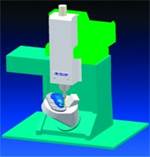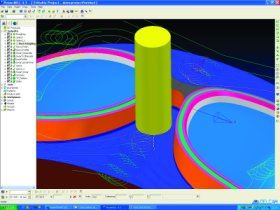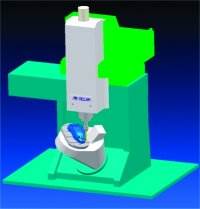Moving High-Technology Machining into the Mainstream: Part I
To achieve the maximum ROI, companies must consider the machining strategies they apply and the supporting software, hardware and cutting tools used.
Neither high-speed machining (HSM) nor five-axis machining can be described as new developments; larger companies have used both techniques for many years. In contrast, until recently, smaller subcontractors and moldmakers have been reluctant to invest in the newer methods, discouraged by the cost of the higher specification machine tools and the increased complexity of CAM programming techniques.
However, the time has come when even smaller companies cannot afford to ignore the opportunities that these new technologies offer to shorten delivery times, boost productivity and increase profitability. It is becoming increasingly apparent that North American companies must adopt these high-productivity technologies if they are to remain competitive and survive in today's aggressive business environment.
Welcome! You’ve unlocked premium content.
Cost Trends
The loss of manufacturing work to countries in Asia that have lower labor costs has been well publicized. Less attention has been given to the Western European companies; potentially, they are a more serious threat because they are dramatically increasing productivity by investing in the latest technology. For example, more than half of the software products that were sold in Europe last year were for continuous five-axis machining. In North America, the proportion was less than 20 percent.
Reducing costs in all of the components of a modern machining operation means that there is less reason than ever to postpone any investment. First of all, the price of both HSM and five-axis machines has been falling steadily and this trend is forecast to continue. In addition, capabilities that were only available on larger machines are now provided on smaller ranges of equipment. Therefore, technology that used to be economic only for the larger companies is now affordable for small- and medium-size moldmakers and production machinists.
Similarly, the cost of specialized cutters, particularly those required for HSM, has also become less. When used correctly, they offer a longer cutting life and can be more economic than conventional tooling. However, they are still more expensive than standard cutters, so the cost of a broken tool remains higher.
Finally, the cost of software and hardware to program both HSM and five-axis machining operations has fallen. This has been most evident on the hardware side, with computing power that would have been unthinkable a few years ago now available at dramatically lower prices. There is simply no excuse for companies to be programming expensive machine tools on computers that are more than three years old. A new replacement will cost only a few thousand dollars and give much faster calculation times.
Even more important has been the huge improvements in programming systems' ease of use for more sophisticated machining options. The time taken to learn modern software has been reduced significantly, meaning that new staff can quickly become more efficient with much lower training costs.
CAD for Advanced Machining Options
Even though programming has become easier, the need for improved process management has become even more important. The importance of starting with a high-quality CAD model when using HSM and five-axis machining has become increasingly apparent, as there is more likelihood that problems with the CAD model will cause machining difficulties. Furthermore, the cost of repairing any damage to the cutter or the spindle will almost certainly be higher with either a high-speed machine or five-axis equipment. By definition, everything happens faster with HSM, so if things do go wrong, they go wrong much more quickly. If the operator sees a potential problem, there are few, if any, opportunities to stop the machine before damage occurs.
The most critical aspect of the CAD data is the tolerance used within the model, which must be set at a finer level than the planned machining tolerance. Adjusting the machining tolerance when manufacturing a poor-quality model will result in defects being more accurately machined. If data is translated between a CAD and a CAM system, the tolerances must be set at the same level. This can be of particular importance if the STL format is used to pass the data between the CAD and CAM systems. STL is normally used for rapid prototyping (RP), where the tolerances are not set as finely as those that are needed for machining. If the tolerances are not adjusted, the end result can be a faceted model that will need a lot of hand finishing to produce a smooth surface.
Another key issue is the trimming of the various surfaces that go together to make up the model. Overlaps or gaps between surfaces can cause a problem for any three-axis machine. However, higher speeds that are used with HSM mean that any attempt to plunge into a minute gap between two surfaces will cause serious damage to the cutter and possibly to the machine tool. These problems can be more serious with five-axis machining since the cutter can be oriented to move between any gaps, even those that a three-axis toolpath might ignore. Again, this can be a common source of difficulty if data is translated between CAD and CAM systems with different tolerances set in the sending and receiving systems. Another recommendation for all machining operations is to ensure that the CAD model contains all the features that need to be machined. In the past, it was common for fillets to be left out of the CAD model and to be formed implicitly by the cutter during machining. With modern CAD systems, filleting is both much easier and done more quickly. Forming these features by machining inevitably involves the risk that they will not be the required result. In addition, this approach puts excessive load on the cutter and on the machine tool, which will result in higher wear or even breakages when using HSM.
Benefits of HSM
Despite years of research, there is not a concise, accepted definition of HSM or a simple explanation of how it really works. However, there is a huge level of practical experience that has confirmed the many benefits of the technique. The basic idea is that by taking light cuts at high speed, material can be removed faster than by taking heavy cuts at lower speed.
Lighter cuts mean reduced cutting forces, so distortion and vibration effects are reduced, and machining accuracy increased. High cutting speeds enable very hard materials, including the harder steels used for moldmaking and the more exotic materials used in the aerospace industry, to be cut with suitable tooling. High cutting speeds also result in most of the energy of the process being dissipated as heat in the chips, reducing thermal distortion of the part.
Using smaller cutters and machining with greater accuracy means that hand finishing can be reduced or even eliminated. Like any manual process, hand finishing is both slow and expensive. In many cases, the time saved by reducing hand finishing can be even greater than that saved through faster machining. Furthermore, hand finishing cannot guarantee the level of consistency between a run of parts or between a series of cavities in a mold tool that is possible from a modern CNC machine tool.
These benefits will not be seen if the machining strategy is inappropriate. Poor strategies usually cause unacceptably short tool life or catastrophic failure. HSM does not simply mean running existing toolpaths with increased spindle speed and feedrate.
High-Efficiency Roughing
The main requirements of high-efficiency roughing strategies are to keep the load on the cutter as consistent as possible to maximize its life and minimize any sudden changes in cutting direction that will involve a slowing in the feed rate. One of the basic strategy changes needed to achieve these conditions is the use of offset machining for roughing rather than the traditional raster approach. Whenever possible, machining should be completed from the centre of the job outwards to minimize any need for full-width cuts.
An even more efficient variant on conventional offset machining is called race line machining. With this option, the roughing passes are progressively smoothed out as the toolpaths move further from the main form. The resulting paths minimize any sudden changes in direction and allow faster machining, with less wear on the cutter and lower stress on the machine tool.
Also introduced is a new roughing strategy that combines offset roughing with trochoidal machining toolpaths that progressively shave material from the block in a circular motion. This avoids high-load cuts that could occur with conventional offset strategies, by switching automatically to a trochoidal motion when the cutter encounters large amounts of material. Using a trochoidal action to remove material in these areas reduces the load on the tool to a more consistent level, allowing higher machining speeds to be maintained.
Initial advice for HSM was to keep both the step-over and step-down small compared to conventional machining. With recent developments in cutting tool technology, that restriction no longer applies. Roughing with deeper cuts is now possible by using a ballnose cutter with four or six flutes that can cut with the side of the tool. However, the step-over still must be comparatively small.
Climb machining is recommended for all roughing operations, as this will reduce tool wear. Although this approach does involve extra air moves, maximizing the speed of the cutting moves can more than compensate for this lost time. A combination of conventional and climb machining can be used safely in finishing operations where less than 0.3 mm of material is being removed.
Rough and finish machining arcing moves should be used when approaching and leaving the job. Plunging onto the surface of the part should be avoided as this slows down the cutter and leaves a dwell mark on the surface. Similarly, arcing moves should be used to link the various cutting moves. The traditional approach of using right-angle moves will require cutting speed to be reduced and also leave dwell marks.
An additional feature to protect the cutter is the automatic fitting of arcs to toolpaths as the tool approaches any steep face. Without the arc, there will be a sudden increase in the tool load as it engages the steep surface. To prevent damage, the feedrate must be reduced so overall machining times will be increased. With the arcs added, a smoother toolpath results that can be run at higher speeds with less wear.
When cutting corners, the radius of the cutter needs to be considerably less than the radius of the corner, so that the maximum contact distance can be kept to less than 30 percent of the circumference of the cutter. This allows sufficient cooling to take place and also avoids a sharp increase on the tool load as it enters the corner.
High-Speed Finishing
The same basic requirements for roughing-consistent tool loading and the fewest possible sudden changes in direction-also are needed for high-speed finishing. To meet these priorities, a combination of strategies is recommended. 3-D offset finishing should be used on flatter areas and Z-level finishing on steeper areas. The 3-D offset toolpaths should be calculated with the surface step-over varying so that a constant cusp height is applied over the part; this will give more even tool loading and reduce the amount of hand finishing. The ability of modern tooling to cut with the side of the tool also can be used with finishing. This allows a spiral path to be used as an alternative to the more common Z-level technique. Instead of using the conventional approach of machining down the job level by level, this new strategy uses a single, smooth toolpath that machines upwards in a spiral from the bottom of the surface. This keeps the cutter in constant contact with the job and eliminates air moves. The smoother toolpaths also minimize any dwell marks and protect the cutter and machine tool.
In this first section, the case for investment has been made. The benefits and strategies of HSM have been outlined. In the next issue, the options for five-axis machining will be covered and some tips will be given on the ways to ensure that your investment gives the expected returns.
Related Content
Three Good Reasons to Switch from Three- to Five-Axis Machining in Moldmaking
Five-axis machining technology is a great tool in the moldmaker toolbox.
Read MoreHow to Eliminate Chatter
Here are techniques commonly used to combat chatter and guidelines to establish a foundation for optimizing the moldmaking process.
Read MoreOEE Monitoring System Addresses Root Cause of Machine Downtime
Unique sensor and patent-pending algorithm of the Amper machine analytics system measures current draw to quickly and inexpensively inform manufacturers which machines are down and why.
Read MoreRead Next
Moving High-Technology Machining into the Mainstream: Part II
Positional and continuous five-axis machining is an essential step in achieving correct ROI and improving delivery times.
Read MoreHow to Use Strategic Planning Tools, Data to Manage the Human Side of Business
Q&A with Marion Wells, MMT EAB member and founder of Human Asset Management.
Read MoreHow to Use Continuing Education to Remain Competitive in Moldmaking
Continued training helps moldmakers make tooling decisions and properly use the latest cutting tool to efficiently machine high-quality molds.
Read More






















